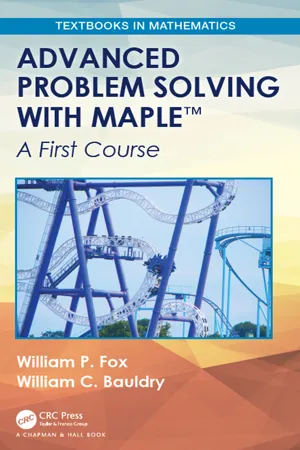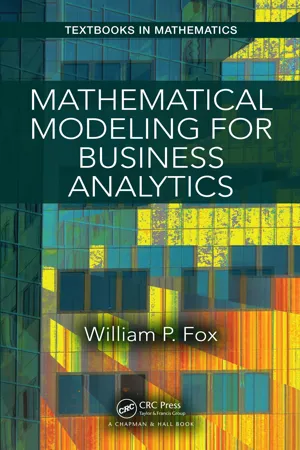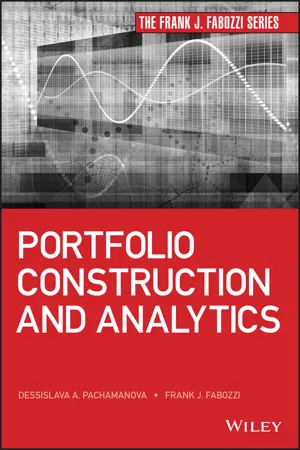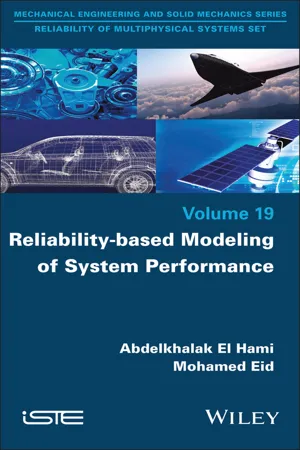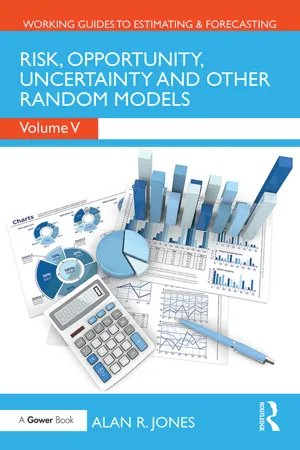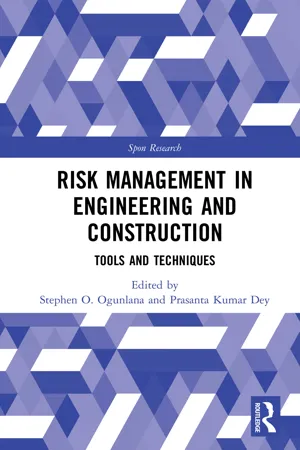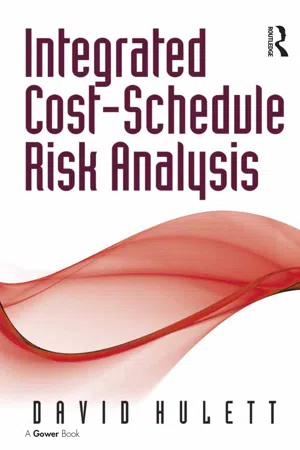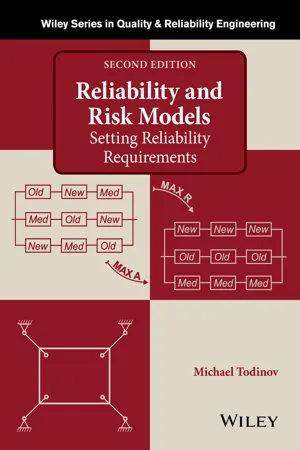Business
Monte Carlo Simulation
Monte Carlo Simulation is a computational technique used to model the impact of uncertainty and risk in decision-making processes. It involves running multiple simulations using random input variables to analyze the range of possible outcomes and their probabilities. In business, it is commonly used for financial forecasting, risk assessment, and optimization of complex systems.
Written by Perlego with AI-assistance
Related key terms
Related key terms
1 of 4
Related key terms
1 of 3
12 Key excerpts on "Monte Carlo Simulation"
- eBook - ePub
Designing High Availability Systems
DFSS and Classical Reliability Techniques with Practical Real Life Examples
- Zachary Taylor, Subramanyam Ranganathan(Authors)
- 2013(Publication Date)
- Wiley-IEEE Press(Publisher)
Chapter 17 Monte Carlo Simulation Models 17.1 Introduction Monte Carlo analysis is a simulation-based technique that enables quick analysis of system models. This technique can be used during requirements and design phases to visualize system behavior and predict system performance and reliability. In this chapter, we consider Monte Carlo Simulations with examples from Excel, Crystal Ball, and Matlab. The Monte Carlo technique was first used by scientists working at the nuclear research lab in Los Alamos, New Mexico and named after the Monaco resort town famous for its casinos. Monte Carlo Simulation has been used to model a wide variety of physical and conceptual systems. It is extensively used in financial planning, business, reliability engineering, and safety engineering for quantitative risk analysis and control. In many engineering and scientific applications, Monte Carlo Simulation is typically the method chosen for evaluating the impacts of parameter uncertainty on model predictions. This methodology allows a full mapping of the uncertainty in model inputs into the corresponding uncertainty in model outputs. Monte Carlo Simulation uses random sampling of either defined or unknown probability distributions representing uncertainty of events or variables of interest. The distributions are used to generate random inputs to a system transfer function which calculates the output values. Each set of samples and resultant outputs is called a trial. The simulation is repeated hundreds or thousands of times with independent random samples selected for each trial. The output values from each trial are stored, and after all trials have been run, the output values are used to create probability distributions. Monte Carlo models can walk through thousands of scenarios and generate predictions by taking randomness into account. It can show the extreme possibilities along with all possible consequences of most likely events - eBook - ePub
Advanced Problem Solving with Maple
A First Course
- William P. Fox, William C. Bauldry(Authors)
- 2019(Publication Date)
- Chapman and Hall/CRC(Publisher)
A modeler may encounter situations where the construction of an analytic model is infeasible due to the complexity of the situation. In instances where the behavior cannot be modeled analytically, or data collected directly, the modeler might simulate the behavior indirectly, and then test various alternatives to estimate how each affects the behavior. Data can then be collected to determine which alternative is best. Monte Carlo Simulation is a common simulation method that a modeler can use, usually with the aid of a computer. The proliferation of computers in today’s society, both in the academic and business worlds, makes Monte Carlo Simulation very attractive. It is imperative that we understand, at a minimum, how to use and interpret Monte Carlo Simulations as a modeling tool.There are many forms of simulation ranging from building scale models such as those used by scientists or designers in experimentation to various types of computer simulations. Monte Carlo Simulation is a preferred type which is implemented using random numbers. There are many serious mathematical concerns associated with the construction and interpretation of Monte Carlo Simulations. We will focus on reinforcing the techniques of simulations with random variates.A principal advantage of Monte Carlo Simulation is the ease with which it can be used to approximate the behavior of very complex systems. Often, simplifying assumptions must be made in order to reduce a complex system into a manageable model. Within the environment forced upon the system, the modeler attempts to represent the real system as closely as possible. This system is probably a stochastic system; however, simulation can allow either a deterministic or stochastic approach; see Figure 7.1 - eBook - ePub
Electric Power Grid Reliability Evaluation
Models and Methods
- Chanan Singh, Panida Jirutitijaroen, Joydeep Mitra(Authors)
- 2018(Publication Date)
- Wiley-IEEE Press(Publisher)
6 Monte Carlo Simulation6.1 Introduction
Monte Carlo Simulation consists of imitating the stochastic behavior of a physical system. The family of methods that fit this description has been named after the city of Monte Carlo in Monaco because of the resemblance of these methods to games of chance. In general, Monte Carlo Simulation methods can be used to imitate any system that exhibits any form of random behavior. In the context of reliability evaluation of a system, Monte Carlo Simulation is used to determine how random failures of the components constituting the system affect the reliability of the system.Monte Carlo Simulation is often used as an alternative to analytical methods. Analytical approaches are efficient and should always be employed when it is possible to develop models that are reasonable representations of the physical systems, and also when such models are amenable to solution. Some problems are, however, too complex to be solved in this manner and simulation techniques have to be used.In simulation, the system is divided into elements whose behavior can be predicted either deterministically or by probability distributions. These elements are then combined to determine the system reliability. Simulation, therefore, also employs a mathematical model, but it proceeds by performing sampling experiments on this mathematical model. Simulation experiments are virtually the same as ordinary statistical experiments, except that they are performed on the mathematical model rather than on the actual system.The mathematical methods discussed in the previous chapters generally give exact results under the assumptions made, except for numerical round-off. Simulation techniques, however, provide only estimates of the exact results. Moreover they provide only a numerical value, and the whole simulation experiment may have to be repeated to obtain results for even slightly different data. Sensitivity analysis, using a simulation approach, could therefore be quite computationally expensive. It is, however, a very flexible approach for large and complex systems. - eBook - ePub
- William Fox(Author)
- 2017(Publication Date)
- Chapman and Hall/CRC(Publisher)
Many undergraduate mathematical science, engineering, and operations research programs currently require or offer a course involving simulation. Typically, such a course will use a high-level simulation language such as C++, Java, FORTRAN, SLAM, Prolog, STELLA, Siman, or GPSS as the tool to teach simulation. Here, we will use Excel to simulate some simple modeling scenarios.Our emphasis is twofold. First, we want you (the student) to think in terms of an algorithm, not a specific language. Second, we want you to understand that more is better in Monte Carlo Simulations. The More Is Better rule is based on the law of large numbers where probabilities are assigned to events in accordance with their limiting relative frequencies.In this chapter our focus is on Monte Carlo Simulation. The concept of Monte Carlo Simulation stems from the study of games of chance. These types of simulations can be accomplished using three distinct steps: (1) generate a random number, (2) define how the random numbers relate to an event, and (3) execute the event as shown in Figure 8.1 . These three steps are repeated lots of times as we will illustrate in our examples.One advantage of dealing with simulations is their ease to examine what if analysis to the systems with actually altering the real system. For example, if we want to design a sensor to detect an illness it is easier to test on a computer simulation than to affect many people and actually the experiment.FIGURE 8.1Three main steps in Monte Carlo Simulations.8.2 Random Number and Monte Carlo SimulationA Monte Carlo Simulation model is a model that uses random numbers to simulate the behavior of a situation. Using a known probability distribution (such as uniform, exponential, or normal) or an empirical probability distribution, a modeler assigns a behavior to a specific range of random numbers. The behavior returned from the random number generated is then used in analyzing the problem. For example, if a modeler is simulating the tossing of a fair coin using a uniform random number generator that gives numbers in the range 0 ≤ x < 1, then he or she may assign all numbers less than 0.5 to be a head, whereas numbers from 0.5 to 1 are tails.A Monte Carlo Simulation can be used to model either stochastic or deterministic behavior. It is possible to use a Monte Carlo Simulation to determine the area under a curve (a deterministic problem) or stochastic behavior such as the probability of winning in craps (a stochastic problem). In this chapter, we will introduce both a deterministic problem and a stochastic problem. We discuss how to create algorithms to solve both. We will start with the deterministic simulation modeling. - eBook - ePub
Essentials of Pricing Analytics
Tools and Implementation with Excel
- Erik Haugom(Author)
- 2020(Publication Date)
- Routledge(Publisher)
Chapter 13Monte Carlo Simulation for pricing decisions
In most cases, managers or other decision-makers do not have perfect information about what the actual consequences of various pricing decisions will be like. Additionally, the properties of the various variables going into a pricing model may be hard to describe with smooth functions, and the pricing problem itself could be so complex that it is impossible to find analytical solutions. In such situations, Monte Carlo Simulation is a valuable tool that can be used to get an overview of the potential outcome of various pricing decisions. Examples of applications include, but are not limited to:• Estimating the probability of breaking-even from a given price change.• Estimating the market response from a range of pricing decisions.• Estimating competitors’ response from a range of pricing decisions.• Setting prices under uncertainty in general.• Setting dynamic prices under uncertainty with a special focus on some variables:• Weather, cannibalization, competitor actions.• Setting mark-down levels under uncertainty with a special focus on:• Response to various mark-down levels, cannibalization fraction.We shall, in this chapter, focus specifically on what Monte Carlo Simulation is, how it can be used when making pricing decisions, and how this powerful technique can be implemented in Excel. Specifically, the chapter will cover the following topics:• What is Monte Carlo Simulation?• How can simulation be used for pricing decisions?• The basics of Monte Carlo Simulations in Excel.• Examples of simulation models for pricing problems.13.1 What is Monte Carlo Simulation?
Monte Carlo Simulation is all about using the computer to draw random numbers in order to replicate elements of the real world. The term Monte Carlo is used because of the similarities between many gambling devices and the process behind simulation using the computer. A device such as the roulette wheel, for example, produces random numbers from a defined range (from 0 to 36). In practice, we could use a roulette wheel to perform simulation of many interesting real-life applications. There is only one drawback, though: It takes a very long time to obtain the random numbers we need. Many simulation projects require thousands of trials, and if you spend on average 30 seconds on each trial, it will take many hours, at best, to run one simple simulation experiment. This is the reason why we use the computer (using Excel for example) to draw the random numbers we need. - eBook - ePub
- William P. Fox, Robert E. Burks(Authors)
- 2021(Publication Date)
- Chapman and Hall/CRC(Publisher)
Many undergraduate mathematical science, engineering, and operations research programs currently require or offer a course involving simulation. Typically, such a course will use a high-level simulation language such as C++, Java, FORTRAN, SLAM, Prolog, STELLA, SIMAN, or GPSS as the tool to teach simulation. Here we will use Excel to simulate some simple modeling scenarios.Our emphasis is twofold. First, we want you (the student) to think in terms of an algorithm, not a specific language. Second, we want you to understand that more is better in Monte Carlo Simulations. The “More Is Better” rule is based on the law of large numbers where probabilities are assigned to events in accordance with their limiting relative frequencies.In this chapter, our focus is on Monte Carlo Simulation. The concept of Monte Carlo Simulation stems from the study of games of chance. These type of simulations can be accomplished using three distinct steps: generate a random number, define how the random numbers relates to an event, execute the event as shown in Figure 9.1 . These three steps are repeated lots of times as we will illustrate in our examples.One advantage of dealing with simulations is there ease to examine “what if” analysis to the systems with actually altering the real system. For example, if we want to design a sensor to detect an illness it is easier to test on a computer simulation than to affect many people and actually experiment.Figure 9.1Three steps in Monte Carlo Simulations.9.2 Random Number and Monte Carlo SimulationA Monte Carlo Simulation model is a model that uses random numbers to simulate behavior of a situation. Using a known probability distribution (such as uniform, exponential, or normal) or an empirical probability distribution, a modeler assigns a behavior to a specific range of random numbers. The behavior returned from the random number generated is then used in analyzing the problem. For example, if a modeler is simulating the tossing of a fair coin using a uniform random number generator that gives numbers in the range 0 ≤x < 1, then he or she may assign all numbers less than 0.5 to be a head while numbers from 0.5 to 1 are tails.A Monte Carlo Simulation can be used to model either stochastic or deterministic behavior. It is possible to use a Monte Carlo Simulation to determine the area under a curve (a deterministic problem) or stochastic behavior like the probability of winning in craps (a stochastic problem). In this chapter, we will introduce both a deterministic problem and a stochastic problem. We discuss how to create algorithms to solve both. We will start with the deterministic simulation modeling. - eBook - ePub
- Frank J. Fabozzi, Dessislava A. Pachamanova(Authors)
- 2016(Publication Date)
- Wiley(Publisher)
14 in Pachamanova and Fabozzi (2010) for more information.Summary
- Monte Carlo Simulation is a valuable tool for evaluating functional relationships between variables, visualizing the effect of multiple correlated variables, and testing strategies.
- Monte Carlo Simulation involves creating scenarios for output variables of interest by generating scenarios for input variables for which we have more information.
- The art of Monte Carlo Simulation modeling is in selecting input probability distributions wisely and interpreting output distributions carefully.
- The distributions of output variables can be analyzed through statistical summaries. Statistics of interest include measures of central tendency (average, median, mode), measures of volatility (standard deviation, percentiles), skewness, and kurtosis.
- Minima and maxima from simulations should be interpreted with care because they often depend on the input assumptions and are very sensitive to the number of trials in the simulation.
- The accuracy of estimation through simulation is related to the number of generated scenarios. Unfortunately, the relationship is nonlinear—in order to double the accuracy, we need to more than quadruple the number of scenarios.
- Random number generation is not trivial, and simulation software packages do not produce truly “random” numbers. There is value, however, in generating random number sequences that are replicable, and thus not completely random.
1 Recall from Chapter 2 that we use tilde (“∼”) to denote uncertain quantities and random variables.2 - eBook - ePub
- Abdelkhalak El Hami, Mohamed Eid(Authors)
- 2023(Publication Date)
- Wiley-ISTE(Publisher)
7 The Monte Carlo Simulation MethodThe Monte Carlo Simulation method is widely used in system reliability and safety analysis. It reveals its full power with the growth of the complexity of the systems. The complexity of a system is not limited to its size, to the number of its constituents and subsystems, to the extent of the physical phenomena in action or to the heterogeneity of the stochastic processes involved, but it also integrates the structural, organizational and regulatory aspects that frame the missions and functionalities of the system. The Monte Carlo method makes it possible to go beyond the limits of the analytical formalism.We do not intend to cover the Monte Carlo method exhaustively: its theoretical bases and the extent of its fields of application. This is beyond the restricted scope of the book. As soon as the basic notions are briefly presented, we will move on to applications with the same care given to the didactic condition as in the previous chapters.7.1. Generation of random variables
Simulation by the Monte Carlo method is based on its ability to generate random variables following a well-defined probabilistic distribution. For example, if we are interested in the uptime before failure of a given component and if we know the probabilistic law that governs the occurrence of its failures, we can then generate this random variable called “Time To Fail – TTF”. We proceed exactly the same way regarding the repair time “Time To Repair – TTR”.Putting the Monte Carlo method into practice requires the use of random variables generators. Two approaches are, in principle, possible to generate random variables: analogical and numerical. We are more interested in the numerical generation of random variables.Some functions called pseudo-random allow us to develop basic generators of random variables with specific probabilistic characteristics. But are we going to develop random variable generators for each family of probabilistic laws? - Alan Jones(Author)
- 2018(Publication Date)
- Routledge(Publisher)
However, we also learnt that in many cases when we are considering cost or schedule, we cannot assume that all the input variables are totally independent of each other. Research has shown that a background correlation in the region of 20% to 30% is a more reasonable assumption than total independence. This has the effect of widening the output distribution, pushing down in the middle and outwards to both sides. We then went on to explore different options we can assume in ‘pushing’ correlation into a model across all its variables such as Chain-Linking and Hub-Linking.Monte Carlo Simulation is often used to model Risks, Opportunities and Uncertainties. These are consequences that may or may not arise, but if they do, they are either detrimental or beneficial respectively. In order to model Risks and Opportunities we need to add a variable for the Probability of Occurrence for each Risk or Opportunity. The effects of this will tend to create models that are less Normalesque, and could indeed be quite markedly positively skewed due to the effects of Risks and Opportunities ‘switching on and off’ in the modelling process. Whilst we can model Risk and Opportunities independently of the Baseline tasks to understand the interaction of these, it is essential that the final Monte Carlo Simulation includes all Risks, Opportunities and Baseline task Uncertainties as a single model as they exist together in a single interactive system.One of the dangers of Monte Carlo Simulation is that we put too much blind faith in the numbers that it generates without thinking about what it is telling us, or is not telling us. It’s not that the way that it does the mathematics, is in any way suspect, but those same calculations do tend to mask the impact of Low Probability, High Impact Risks. Unless we select the very high end of the Confidence Range, then this class of Risks will not be covered by a more competitive output value from the model; there will be a high residual Risk exposure in the event (albeit unlikely by definition) of the Risk occurring. We have to make a conscious decision on whether:- We can (and therefore should) mitigate the Risk
- Pass the Risk back to the customer/client (i.e. exclude it), who only pays if it occurs
- eBook - ePub
Risk Management in Engineering and Construction
Tools and Techniques
- Stephen Ogunlana, Prasanta Kumar Dey, Stephen Ogunlana, Prasanta Kumar Dey(Authors)
- 2019(Publication Date)
- Routledge(Publisher)
A fundamental challenge to the construction industry regarding innovation is the planning and control of work during the implementation phase. The implementation of innovation highlighted the influence information that affects the innovation process. Developing a simulation tool to plan the implementation requires testing this process against information that influences its implementation. As this information may alter the innovative project objectives (i.e. time or cost) from the initial ones, there is a need to simulate these deviations using a sensible and reliable tool to help managers monitor their plans. The proposed simulation will change the planning type from deterministic to stochastic. A planning tool has been designed for this purpose.The proposed tool uses the Monte Carlo technique to analyse the effect of risk on the innovation process. The use of this technique will allow managers to investigate:• the sensitivity of the implementation tasks to the subjective estimates used within the influence information; • different durations/costs of the interdependent tasks for each stage; • information that most critically influences implementation.The principles of the Monte Carlo technique will be illustrated first. Then an example will be presented to demonstrate the use of the technique.Monte Carlo techniqueFor the purpose of simulating construction processes, such as innovation in construction, two main considerations have to be taken into account, namely deterministic or stochastic simulation and discrete or continuous change.The deterministic simulation is for systems whose behaviour is completely predictable. An example of this system is the traditional planning of projects. A stochastic simulation is for a system whose behaviour cannot be completely predictable which fits well with the characteristics of innovation process information, as described above. The stochastic simulation refers to using mathematical models to study systems that are characterised by the occurrence of random events.The main difference between discrete and continuous change is that the former deals only with variables that are not changed during the simulation process while the latter allows continuous change for the variables’ values during the simulation run. These changes could be represented by differential equations that, theoretically, allow variables to be computed at any period of time. - eBook - ePub
- David Hulett(Author)
- 2016(Publication Date)
- Routledge(Publisher)
Monte Carlo Simulation also recognizes the uncertainty that we have put into the model for those elements’ costs that we do not know with clarity. The cost model with the line items used in this chapter is shown in Table 3.1. Table 3.1 Estimate with 3-point ranges representing cost risk • Monte Carlo recognizes the distributions that we have put into the cost model. It knows the shape of those distributions and the parameters (3-point estimates) because we have specified those. • Monte Carlo “runs” or “iterates” the project multiple times, creating often thousands of projects that could represent our own. For each iteration Monte Carlo selects at random a cost for each project element and calculates the total cost of the project for that iteration by summing those elements. Each of these iterations represents a possible project since it creates a different possible project every time by taking its costs from the cost probability distributions specified by the analyst. • The way Monte Carlo selects the costs at random for each cost element and for each iteration is to use the cumulative distribution implied by the 3-point estimate and the distribution chosen (triangular in this case) for each of the uncertain project element input distributions. For each iteration and for each project element the simulation software selects at random a number from 0 to 1.0 using the computer’s random number generator. This value is placed along the Y-axis of the project element’s cumulative distribution. (In our case with the six project elements shown in Table 3.1 there are six random numbers are selected and used for each iteration.) This random number is translated into a specific cost by the cumulative distribution derived from the 3-point estimate of that project element, and that cost value is used for that element in that iteration - eBook - ePub
Reliability and Risk Models
Setting Reliability Requirements
- Michael Todinov(Author)
- 2015(Publication Date)
- Wiley(Publisher)
8 Solving Reliability and Risk Models Using a Monte Carlo Simulation 8.1 Monte Carlo Simulation Algorithms 8.1.1 Monte Carlo Simulation and the Weak Law of Large Numbers Monte Carlo Simulation is a powerful method for determining empirically the probability of an event. If the number of independent trials leading to outcome A is and the total number of trials is n, the probability of the outcome A can be approximated from (8.1) for a sufficiently large number of trials n. It can be shown that (8.2) for each. This fundamental result, which is the foundation of the Monte Carlo method, is known as Bernoulli’s weak law of large numbers. It was first proved by Jacob Bernoulli in his work Ars Conjectandi (1713) (Bernoulli, 1899). Proof Let denote the outcome on the i th trial. If the outcome is event A, then ; otherwise,. Because the trials are independent, the random variables are statistically independent and identically distributed. The common mean of the random variables can be determined from (8.3) Because the number of outcomes leading to event A is given by, to prove expression (8.2), it can be presented as (8.4) for each, where. Before we prove (8.4), the following inequality (known also as Chebyshev’s inequality) will be proved. If X is a discrete random variable with mean and finite variance, then, for each positive number a > 0, (8.5) The inequality states that the probability that a random variable X will deviate by more than a from its mean does not exceed the ratio. Let X accept its discrete values x, with probabilities. Indeed, by definition,. If the summation is made only over values for which (Figure 8.1, the region marked with a thick line), the following inequality holds because both and : (8.6) If is replaced by, then (8.7) will hold
Index pages curate the most relevant extracts from our library of academic textbooks. They’ve been created using an in-house natural language model (NLM), each adding context and meaning to key research topics.
Explore more topic indexes
Explore more topic indexes
1 of 6
Explore more topic indexes
1 of 4

